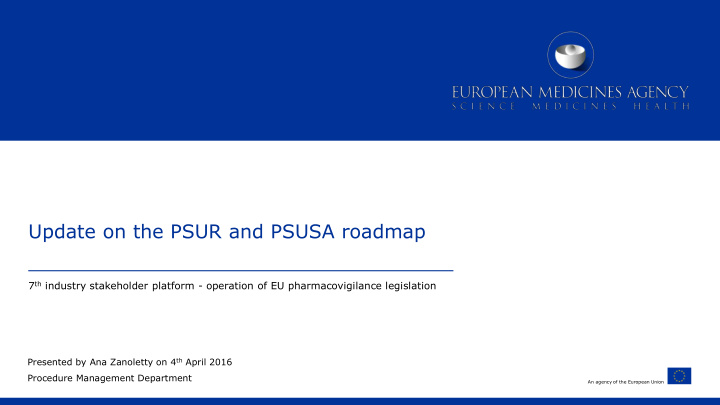



Update on the PSUR and PSUSA roadmap 7 th industry stakeholder platform - operation of EU pharmacovigilance legislation Presented by Ana Zanoletty on 4 th April 2016 Procedure Management Department An agency of the European Union
Agenda • Introduction • PSUR Roadmap and issues it will address • Agreed principles and implementation timeline • Questions and discussion 1
Introduction Concept of the PSUR, its assessment and role in the lifecycle of a medicinal product New (critical appraisal) Pharmacovigilance legislation -> PSUR changes in PSUR Evidentiary standards submission requirements in submissions and and content; Roadmap outcomes strengthened coordination -> Increased experience Increased challenges Regulatory follow-up after procedure or for issues detected during assessment 2
PSUR Roadmap elements Explanatory note to GVP VII update PRAC/CMDh EMA PSUR Q&A workshop & Standard written Consultation/finalisation recommendations via joint industry/assessor consultation process webinar Training, industry meetings AR template CMDh template update & proactive Joint industry/assessor updates, Q&A publication training envisaged; 7 th Industry platform meeting, DIA PSUR info day Industry involvement 3
Honing in on the issues – PRAC/CMDh workshop (Jan 2016) Regulatory PSUR follow-up Concept of assessment, after PSUR the PSUR and conclusion procedure or presentation its and for issues and content assessment assessment detected report during assessment 4
What should drive for the assessment of a PSUR • (single) assessment? Concept of the PSUR and its Can a PSUR procedure add a new indication to • assessment approved medicinal products? Reaching a common position on the B/R when different • indications may be authorised in different MS and the level of information included in the SmPC may be very different as well? Strength and nature of the evidence needed to support • regulatory action? Does this differ depending on the stage in a medicinal product’s lifecycle? 5
Lack of experience/knowledge in the submission of • data some PSURs: e.g. safety specifications are all PSUR presentation the adverse events listed in section 4.8; information and content is not placed in the correct sections; no critical analysis of the data…): What is the level of evidence/information that should be provided, especially in the particular context of the EU single assessment in each of these sections? Setting the Reference Safety Information in the • context of the product information in EU 6
• Handling of refuted signals and further follow up PSUR assessment, • Handling of close monitoring and what is expected of conclusion and the MAH assessment report • Can/should the PSUSAs be used as a tool for harmonisation of the SmPC/PL? • Can/should the PSUSAs be used as a tool for harmonisation of the safety specifications? • Implementation of outcomes from other procedures? • Conclusions on combination PSUSAs vs mono substances and vice versa? 7
What is the regulatory/procedural position in cases • Regulatory follow-up or where during the PSUSA assessment non- for issues detected compliance with previous EU positions (e.g. PV during assessment referral) are detected? What to do when an issue cannot be finalised within • the PSUSA? Implementation of PSUSA outcomes at national • level? 8
PRAC/CMDh workshop & Starting point - key principles (Industry focus) recommendations • Reliance on the data (interval & cumulative) provided in PSUR importance of data quality prerequisite for adequate assessment • The PSUSA is not a tool for harmonisation of product information. Consider using other procedures to reach harmonisation • Update of safety specifications only if important new risks. Safety evaluation needs to be in context of the reference safety information (RSI) and not based on each national SmPC for a product and the RSI needs to be set into EU context. 9 • Improve communication on timeframe for implementation of NAPs outcomes
PRAC/CMDh workshop & recommendations Starting point - key principles (Assessor focus) • Critical appraisal should be undertaken considering the maturity of the product and its place in therapeutics • Preparation is key, potentially reducing need for follow up; early discussion at PRAC where helpful • New section for “Other considerations” in PRAC AR to flag important issues Follow up requests should be exceptional and scientifically justified (process under • discussion at CMDh) • EURD List updates should involve GPAG 10
Implementation timeline Apr May Jun Jul Aug Sep Oct Nov Dec Workshop PRAC and recommendations CMDh Finalise consultation and agreement AR template Update of template, consultation and 11-13 Bratislava presidency meeting publication Call for interest drafting group for explanatory note/ GVP update and constitution Questions Update Explanatory note/ to the Drafting Consultation and finalization of the Start GVP update GVP update network Q&A Drafting , consultation and publication CMDh Q&A Revision templates, CMDh templates consultation/roll-out Change in AR Transition timelines arrangements SCOPE Hints & Tips paper 4 Apr Industry Platform Pharmacovigilance 28 Oct DIA info day Oct/Nov joint industry/assessor training Change in AR timelines 11
Questions and discussion 12
Thank you for your attention Further information Ana.zanolettyperez@ema.europa.eu European Medicines Agency 30 Churchill Place • Canary Wharf • London E14 5EU • United Kingdom Telephone +44 (0)20 3660 6000 Facsimile +44 (0)20 3660 5555 Send a question via our website www.ema.europa.eu/contact Follow us on @EMA_News
Recommend
More recommend